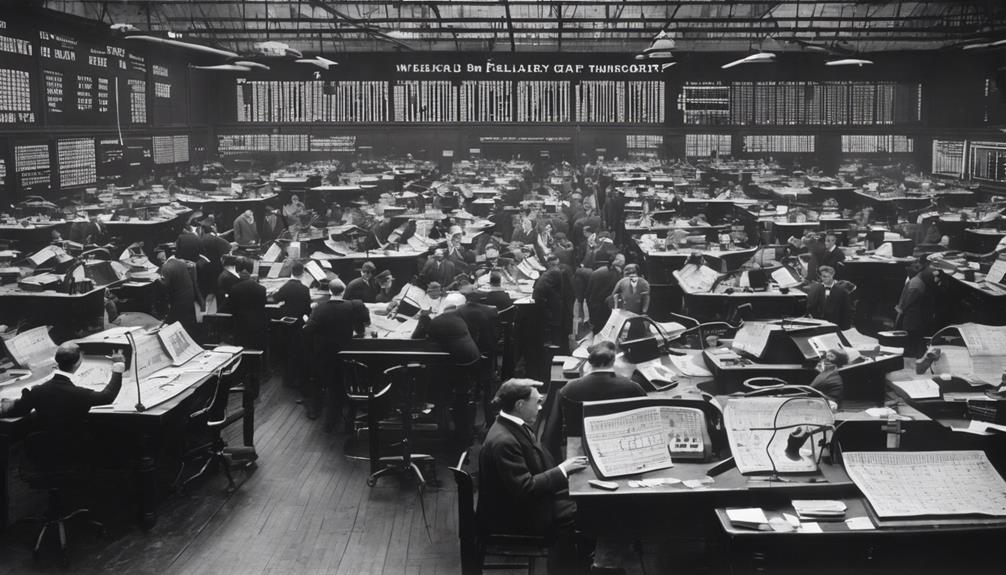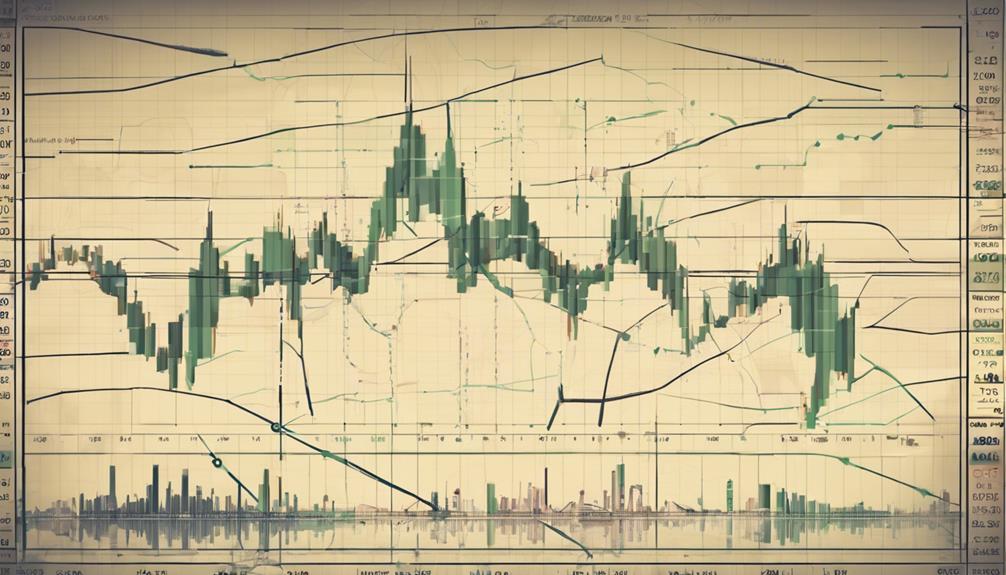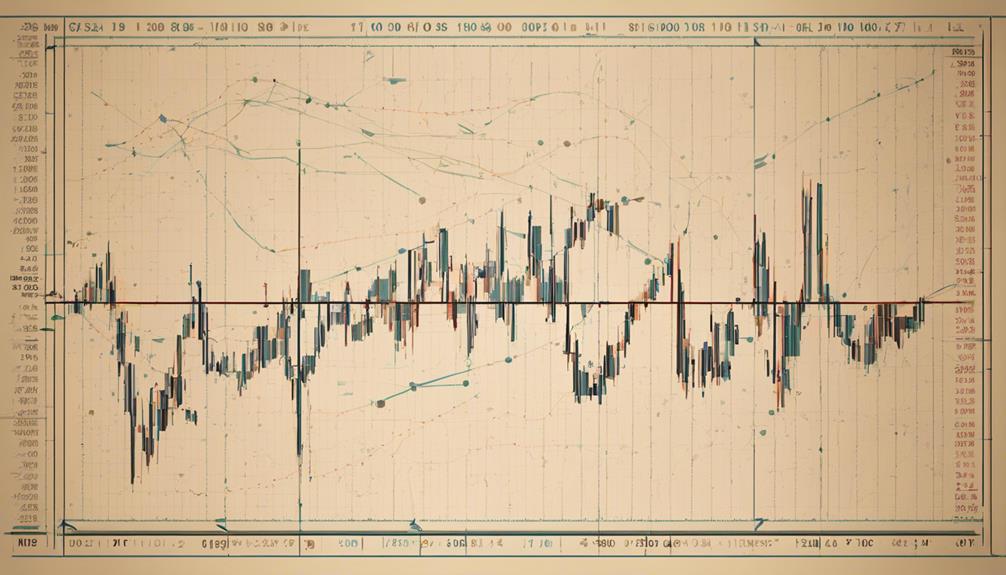As we delve into the historical significance and application of Gann Theory, a fascinating realm of financial analysis awaits exploration.
Originating in the early 20th century, this methodology devised by W.D. Gann combines mathematical precision with celestial phenomena to forecast market movements. Through the lens of Gann angles and intricate patterns, traders have harnessed its predictive power with remarkable accuracy.
In a landscape marked by constant evolution, the endurance and adaptability of Gann Theory in modern financial markets beckon us to uncover its enduring impact and practical implications for today's investors.
Origins of Gann Theory
Developed by W.D. Gann in the early 1900s, Gann Theory delves into the intricate realms of mathematical and astronomical cycles within market analysis. Gann, a legendary trader and market analyst, introduced a unique approach that focused on the relationship between price and time.
Trading based on Gann Theory involves studying historical market data to identify recurring patterns and cycles. Traders utilizing Gann Theory analyze angles, patterns, and time cycles to forecast future market movements accurately. Gann emphasized the importance of both Pattern Study and Time Study in his approach, highlighting the cyclical nature of markets and the significance of historical references in predicting market trends.
Evolution in Financial Markets

How has the evolution of financial markets influenced the application and adaptation of Gann Theory's principles in modern trading practices?
Since the early 1900s, financial markets have undergone significant transformations, shaping the way Gann Theory is utilized today. Originally known for its innovative use of mathematical and astronomical cycles to forecast market movements, Gann Theory has evolved alongside modern financial markets. Technological advancements and the introduction of new trading instruments have led to the integration of Gann Theory's principles into contemporary trading strategies.
In today's dynamic markets, Gann Theory remains relevant by providing insights into market dynamics, forecasting price trends, and identifying key support and resistance levels. Traders and analysts continue to leverage Gann angles and principles to interpret market movements and make informed decisions. The adaptation of Gann Theory to modern trading instruments reflects its enduring value in understanding market behavior and predicting future price movements effectively. As financial markets evolve, Gann Theory continues to play a vital role in analyzing market trends and supporting traders in navigating the complexities of the financial world.
Practical Applications for Traders

Applying Gann Theory in trading practices empowers traders with a structured methodology for identifying critical support and resistance levels, predicting market trends, and strategically setting stop losses and profit targets across diverse financial instruments. This systematic framework enhances traders' ability to make informed decisions based on historical price movements and mathematical principles.
The practical applications of Gann Theory include:
- Support and Resistance Identification: Gann Theory aids traders in pinpointing key levels where the price is likely to experience barriers or support, crucial for making entry and exit decisions.
- Predicting Trend Changes: By analyzing cycles and patterns, traders can anticipate potential shifts in market direction, enabling them to adjust their strategies accordingly.
- Setting Stop Losses and Profit Targets: Gann Theory provides insights into possible price reversals, helping traders establish effective risk management strategies.
- Applicability to Various Financial Instruments: Its versatility allows traders to apply Gann Theory across different markets, offering a comprehensive approach to trading strategies.
Enduring Relevance Today

The enduring relevance of Gann Theory in modern trading practices today is underscored by its proven accuracy in predicting market movements and providing traders with valuable insights for making informed decisions amidst dynamic financial landscapes. Traders continue to rely on Gann angles and time cycles for forecasting support, resistance, and trend changes, allowing them to anticipate potential market movements with a systematic approach.
The application of Gann Theory remains crucial for navigating stock market trends and facilitating sound trading decisions in volatile market conditions. By leveraging the principles of Gann Theory, traders can analyze historical data to identify patterns that help them anticipate trend reversals and capitalize on emerging opportunities.
The timeless nature of Gann Theory's techniques equips traders with the tools needed to interpret market dynamics effectively and make strategic decisions based on a comprehensive understanding of market behavior.
Impact on Modern Investing

Influencing contemporary investment strategies, Gann Theory has significantly impacted modern financial practices through its emphasis on market cycles and the integration of mathematical and astronomical principles. This impact can be observed in various aspects of modern investing, including predicting market trends, identifying crucial support and resistance levels, and assisting in the establishment of effective stop losses.
- Predicting Market Trends: Gann Theory provides traders with a framework to anticipate potential market movements based on historical price patterns and cyclical analysis.
- Identifying Support and Resistance Levels: Utilizing Gann Theory aids in determining key levels where asset prices may stall or reverse, offering valuable insights for strategic entry and exit points.
- Informed Decision-Making: Traders can leverage Gann Theory to make well-informed decisions across a spectrum of financial instruments, enhancing their overall trading strategies.
- Accuracy Debate and Analysis Tools: The effectiveness of Gann Theory in modern markets remains a subject of debate, necessitating the integration of additional analysis tools and a deep understanding of prevailing market conditions for optimal results.
What are some historical examples of Gann Theory being used successfully in technical analysis?
One of the historical examples of Gann theory in analysis is the successful prediction of market movements by W.D. Gann himself. He famously used his theories to profit from the stock and commodities markets in the early 20th century. Another example is the application of Gann theory by traders in the 1980s to forecast price movements in the financial markets.
Frequently Asked Questions
What Is the Application of Gann Theory?
Gann Theory's application lies in predicting market trends and price movements. It assists traders in identifying support and resistance levels, forecasting trend changes, and setting profit targets. This structured framework is utilized across various financial instruments for informed trading decisions.
How Accurate Is Gann Theory?
Gann Theory's accuracy varies based on interpretation, market conditions, and the trader's analytical skills. Its predictive power, claiming up to 90% accuracy, requires a deep understanding of historical data and the correct application of Gann tools.
What Is the Gann Trend Theory?
The Gann Trend Theory is a robust technical analysis approach that delves deep into market trends, aiding traders in making informed decisions. It leverages historical patterns to predict future price movements and highlights the cyclical nature of markets.
What Are the Important Gann Degrees?
Key Gann degrees include 1X1, 1X2, and 2X1 angles. The 1X1 angle denotes balance in price and time movements, while 1X2 signifies stronger trends. The 2X1 angle indicates potential support or resistance levels. Traders utilize these angles to gauge market dynamics.
Conclusion
In the intricate tapestry of financial markets, Gann Theory stands as a timeless compass, guiding traders through the ebbs and flows with unparalleled precision.
Like a celestial navigator charting the stars, Gann angles illuminate the path to future price movements with remarkable accuracy.
As markets evolve and trends shift, the enduring relevance of Gann Theory shines brightly, illuminating the way for modern investors seeking to unlock the secrets of market dynamics.


